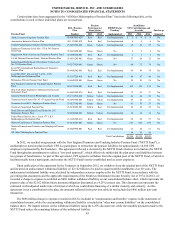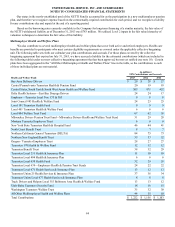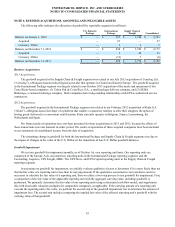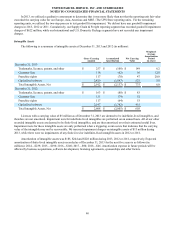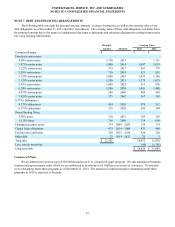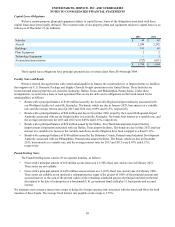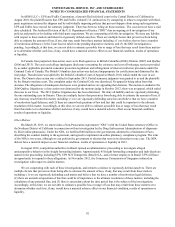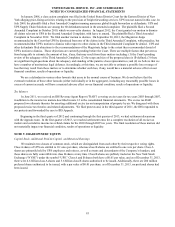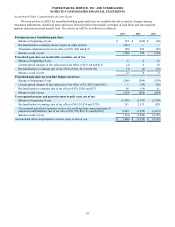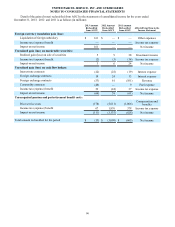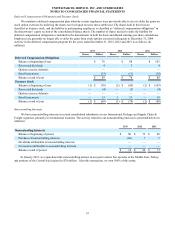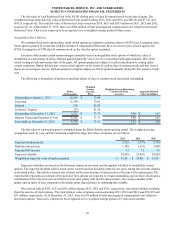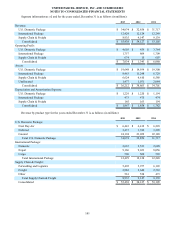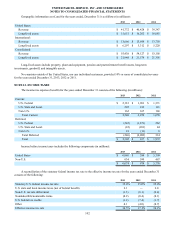UPS 2013 Annual Report Download - page 105
Download and view the complete annual report
Please find page 105 of the 2013 UPS annual report below. You can navigate through the pages in the report by either clicking on the pages listed below, or by using the keyword search tool below to find specific information within the annual report.UNITED PARCEL SERVICE, INC. AND SUBSIDIARIES
NOTES TO CONSOLIDATED FINANCIAL STATEMENTS
93
In January 2008, a class action complaint was filed in the United States District Court for the Eastern District of New
York alleging price-fixing activities relating to the provision of freight forwarding services. UPS was not named in this case. In
July 2009, the plaintiffs filed a First Amended Complaint naming numerous global freight forwarders as defendants. UPS and
UPS Supply Chain Solutions are among the 60 defendants named in the amended complaint. The plaintiffs filed a Second
Amended Complaint in October 2010, which we moved to dismiss. In August 2012, the Court granted our motion to dismiss
all claims relevant to UPS in the Second Amended Complaint, with leave to amend. The plaintiffs filed a Third Amended
Complaint in November 2012. We filed another motion to dismiss. On September 20, 2013, the Magistrate Judge
recommended to the Court that UPS be dismissed from one of the claims in the Third Amended Complaint, with prejudice, but
recommended that UPS's motion to dismiss with respect to other claims in the Third Amended Complaint be denied. UPS and
other defendants filed objections to the recommendations of the Magistrate Judge to the extent they recommended denial of
UPS's motion to dismiss. Those objections are currently pending before the Court. There are multiple factors that prevent us
from being able to estimate the amount of loss, if any, that may result from these matters including: (1) the Court's pending
review of the adequacy of the Third Amended Complaint; (2) the scope and size of the proposed class is ill-defined; (3) there
are significant legal questions about the adequacy and standing of the putative class representatives; and (4) we believe that we
have a number of meritorious legal defenses. Accordingly, at this time, we are not able to estimate a possible loss or range of
loss that may result from these matters or to determine whether such loss, if any, would have a material adverse effect on our
financial condition, results of operations or liquidity.
We are a defendant in various other lawsuits that arose in the normal course of business. We do not believe that the
eventual resolution of these other lawsuits (either individually or in the aggregate), including any reasonably possible losses in
excess of current accruals, will have a material adverse effect on our financial condition, results of operations or liquidity.
Tax Matters
In June 2011, we received an IRS Revenue Agent Report ("RAR") covering excise taxes for tax years 2003 through 2007,
in addition to the income tax matters described in note 12 to the consolidated financial statements. The excise tax RAR
proposed two alternate theories for asserting additional excise tax on transportation of property by air. We disagreed with these
proposed excise tax theories and related adjustments. We filed protests and, in the third quarter of 2011, the IRS responded to
our protests and forwarded the case to IRS Appeals.
Beginning in the third quarter of 2012 and continuing through the first quarter of 2013, we had settlement discussions
with the Appeals team. In the first quarter of 2013, we reached settlement terms for a complete resolution of all excise tax
matters and correlative income tax refund claims for the 2003 through 2007 tax years. The final resolution of these matters did
not materially impact our financial condition, results of operations or liquidity.
NOTE 9. SHAREOWNERS’ EQUITY
Capital Stock, Additional Paid-In Capital, and Retained Earnings
We maintain two classes of common stock, which are distinguished from each other by their respective voting rights.
Class A shares of UPS are entitled to 10 votes per share, whereas class B shares are entitled to one vote per share. Class A
shares are primarily held by UPS employees and retirees, as well as trusts and descendants of the Company’s founders, and
these shares are fully convertible into class B shares at any time. Class B shares are publicly traded on the New York Stock
Exchange (“NYSE”) under the symbol “UPS.” Class A and B shares both have a $0.01 par value, and as of December 31, 2013,
there were 4.6 billion class A shares and 5.6 billion class B shares authorized to be issued. Additionally, there are 200 million
preferred shares authorized to be issued, with a par value of $0.01 per share; as of December 31, 2013, no preferred shares had
been issued.


